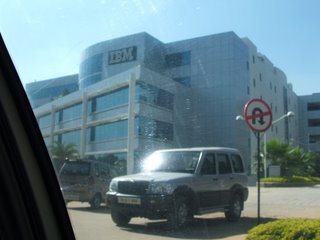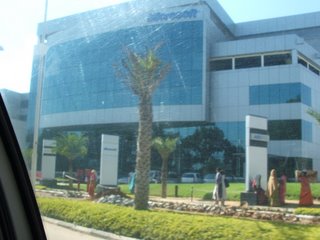Fortune Favors the Prepared Mind
I'm not finished yet, but I can already tell that The World is Flat [Updated and Expanded]: A Brief History of the Twenty-first Century
The email had "Fortune Favors the Prepared Mind" as the subject line and read as follows:
A friend of mine recommended The World is Flat [Updated and Expanded]: A Brief History of the Twenty-first Century
See also some great quotes from the book at www.wikiquote.org.
Some samples:
Every morning in Africa, a gazelle wakes up.
It knows it must run faster than the fastest lion or it will be killed.
Every morning a lion wakes up.
It knows it must outrun the slowest gazelle or it will starve to death.
It doesn’t matter whether you are a lion or a gazelle.
When the sun comes up, you better start running.
-African proverb
• In the pathbreaking 1989 essay, “Computer and Dynamo: the Modern Productivity Paradox in a Not-Too Distant Mirror,” the economic historian Paul A. David explained such a lag by pointing to a historical precedent. He noted that while the lightbulb was invented in 1879, it took several decades for electrification to kick in and have a big economic and productivity impact. Why? Because it was not enough just to install electric motors and scrap the old technology – steam engines. The whole way of doing manufacturing had to be reconfigured. In the case of electricity, David pointed out, the key breakthrough was in how buildings, and assembly lines, were designed and managed. Factories in the steam age tended to be heavy, costly multistory buildings designed to brace the weighty belts and other big transmission devices needed to drive steam-powered systems. Once small, powerful electric motors were introduced, everyone hoped for a quick productivity boost. It took time, though. To get all the savings, you needed to redesign enough buildings with small electric motors powering machines of all sizes. Only when there was a critical mass of experienced factory architects and electrical engineers and managers, who understood the complementarities among the production line, did electrification really deliver the productivity breakthrough in manufacturing, David wrote.
Bill Gates: 30 years ago, if you had a choice between being born a genius on the outskirts of Bombay or Shanghai or being born an average person in Poughkeepsie, you would take Poughkeepsie, because your chances of thriving and living a decent life there, even with average talent, were much greater. But as the world has gone flat, and so many people can plug and play from anywhere, natural talent has started to trump geography.
• America integrated a broken Europe and Japan into the global economy after World War II, with both Europe and Japan every year upgrading their manufacturing, knowledge, and service skills, often importing and sometimes stealing ideas and equipment from the US, just as America did from Britain in the late 1770s. Yet in the sixty years since World War II, our standard of living has increased every decade, and our unemployment rate – even with all the outcry about outsourcing – stands at only a little above 5 percent, roughly half that of the most developed countries in Western Europe.
• By automating these jobs, it enables companies to save money and free up talented brainpower from relatively mundane tasks to start new businesses in other areas. You should be afraid of free markets only if you believe that you will never need new medicines, new work flow software, new industries, new forms of entertainment, new coffeehouses.
• It takes a leap of faith, based on economics, to say there will be new things to do. But there always have been new jobs to do, and there is no fundamental reason to believe the future will be different. Some 150 years ago, 90 percent of American worked in agriculture and related fields. Today, it’s only 3 or 4 percent. What if the government had decided to protect and subsidize all those agricultural jobs and not embrace industrialization and then computerization? Would America as a whole really be better off today? Hardly.
• Well, here’s the truth that no one wanted to tell you: The world has been flattened. As a result of the triple convergence, global collaboration and competition – between individuals and individuals, companies and individuals, companies and companies, and companies and customers – have been made cheaper, easier, more friction-free, and more productive for more people from more corners of the earth than at any time in the history of the world.
• The sense that our kids have to be swaddled in cotton wool so that nothing bad or disappointing or stressful ever happens to them at school is, quite simply, a growing cancer on American society.
• In China today, Bill Gates is Britney Spears. In America today, Britney Spears is Britney Spears – and that is our problem.
• As exciting and as visible as the flat Indian high-tech sector is, have no illusions: It accounts for 0.2 percent of employment in India. Add those Indians involved in manufacturing for export, and you get a total of 2 percent of the employment in India.
• Immigrants are always hungry and they don’t have a backup plan. Young Chinese, Indians, and Poles are not racing us to the bottom. They are racing us to the top. They do not want to work for us; they don’t even want to be us. They want to dominate us.
• The best companies outsource to win, not to shrink. They outsource to innovate faster and more cheaply in order to grow larger, gain market share, and hire more and different specialists – not to save money by firing more people. (p. 360)
• The business organization consultant Michael Hummer once remarked, “One thing that tells me a company is in trouble is when they tell me how good they were in the past. Same with countries. You don’t want to forget your identity. I am glad you were great in the 14th century, but that was then and this is now. When memories exceed dreams, the end is near. The hallmark of a truly successful organization is the willingness to abandon what made it successful and start fresh.
• People don’t change when you tell them there is a better option. They change when they conclude that they have no other option.
• Louis Pasteur said it a long time ago: “Fortune favors the prepared mind.”
The postings on this site are my own and don't necessarily represent IBM's positions, strategies, or opinions.








